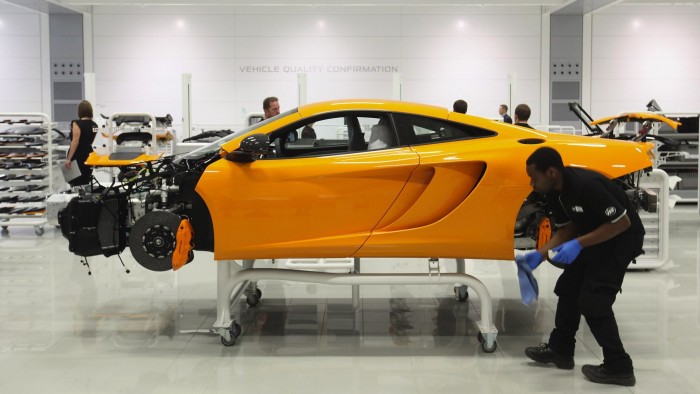McLaren looks to cheaper models to drive growth

Roula Khalaf, Editor of the FT, selects her favourite stories in this weekly newsletter.
McLaren is attempting to rev up its carmaking business by doubling sales volumes this year, as it launches a range of cheaper, more practical sports vehicles.
Having sold roughly 1,500 cars in each of the past two years, the British maker of the P1, a 200mph “hypercar” that sells for as much as £2m, is aiming for at least 3,000 this year — with an ultimate goal of about 4,000 annual sales.
Its expansion hinges on a range of cheaper cars that still carry what Mike Flewitt, chief executive, calls “McLaren DNA” — industry parlance for lightweight, technologically advanced road cars with dramatic, dihedral doors.
“It is economics,” says Mr Flewitt. “You couldn’t just be a P1 company and generate the returns to keep investing in new products.”
McLaren’s road car business was born out of Formula One defeat. After the 1988 Italian Grand Prix — the only race McLaren-Honda failed to win that season — team boss Ron Dennis commissioned the McLaren F1, now widely seen as the best ever supercar.
The latest expansion by the racing team’s sister company, carmaker McLaren Automotive, follows a miserable F1 season last year.
Its new range, starting with the 540C — which will be capable of 199mph but will sell for £126,000 — puts McLaren into competition with a crop of formidable yet relatively affordable sports cars, such as the Audi R8 and the Porsche 911.
McLaren believes that at the lower price point — including the £136,000 570S — there are five times as many potential buyers as at £200,000, roughly the price of the next model up, the 650S.
“It’s a logical next step for McLaren,” says Mark Fulthorpe, analyst at IHS Automotive. “It’s in that sweet spot where you’d be able to attract people previously buying at the top end of the Porsche range.”
The first six months of production of the 570S is already sold out.
Nevertheless, McLaren faces a similar dilemma to Britain’s other sports car makers, Aston Martin and Lotus.
Each manufacturer needs to raise volumes to finance research and development for new models, but must do so by stretching their brands without alienating core customers. For Aston and Lotus, this means family-friendly sport utility vehicles but McLaren — like Ferrari — has ruled out such a move.
Instead, it is expected to unveil a new “grand touring” version of the 570S at the upcoming Geneva motor show, offering more boot space, more comfortable suspension and burnishing McLaren’s credentials as a maker of practical sports cars.
“The fact that you’ve got a Focus in the range doesn’t make the Mondeo less attractive,” says Mr Flewitt, a former manufacturing manager at Ford of Europe.
That kind of pragmatism marks a change for McLaren, which began as a standalone company in 2009, and carved out a niche as a maker of track-focused sports cars for rich motorsport fanatics.
McLaren Automotive is fiscally separate from the McLaren Technology Group — which includes the F1 team and an applied technologies consulting division.
The autos business made its first car in 2011 and its first pre-tax profit in the 2013 financial year. It is expected to have achieved a third year of profitability in 2015, though only in the low single-digit millions. The operating profit margin, at less than 5 per cent in 2014, remains low compared with Ferrari and Porsche at more than 15 per cent.
If McLaren delivers on its promise to sell at least 3,000 cars this year, it would provide a boost for the British economy. The company sources 50 per cent of parts by value in the UK. Shoreham-based supplier Ricardo builds the company’s twin-turbo V8 engines.
McLaren is also adding a second shift at its Woking factory as it more than doubles daily production to about 20 cars. It will take on 250 shop floor staff at the modern, near-silent facility adjacent to the Norman Foster-designed McLaren Technology Centre.
Its move comes as Aston Martin is seeking to double its production capacity. Aston announced on Wednesday that it would invest £200m in a new manufacturing plant in Wales, creating 1,000 jobs.
McLaren’s new sports series will use aluminium body panels, rather than carbon fibre, to reduce costs. The models do away with features such as hydraulically linked suspension and active aerodynamics.
“All of these things are quite techy — they’re not that obvious all the time,” says Matt Prior, chief tester for Autocar magazine. Far from being a cheap option, he says the 570S is the best road car McLaren has made.
Still McLaren’s shareholders want to see better returns from the company. Mumtalakat, the Bahraini state holding company, owns 50 per cent of the carmaking arm, having first taken a stake in 2007.
Mr Flewitt presented a seven-year business plan in December and, despite persistent rumours that the sovereign wealth fund wants to reduce its stake, says shareholders support the expansion plan and are not looking for the exit just yet.
“Does it make McLaren a more attractive company for any [initial public] offering? Yes it does,” he says. “But it doesn’t make it any more likely that we’ll do one. The motivating force is building a more sustainable business.”
Comments